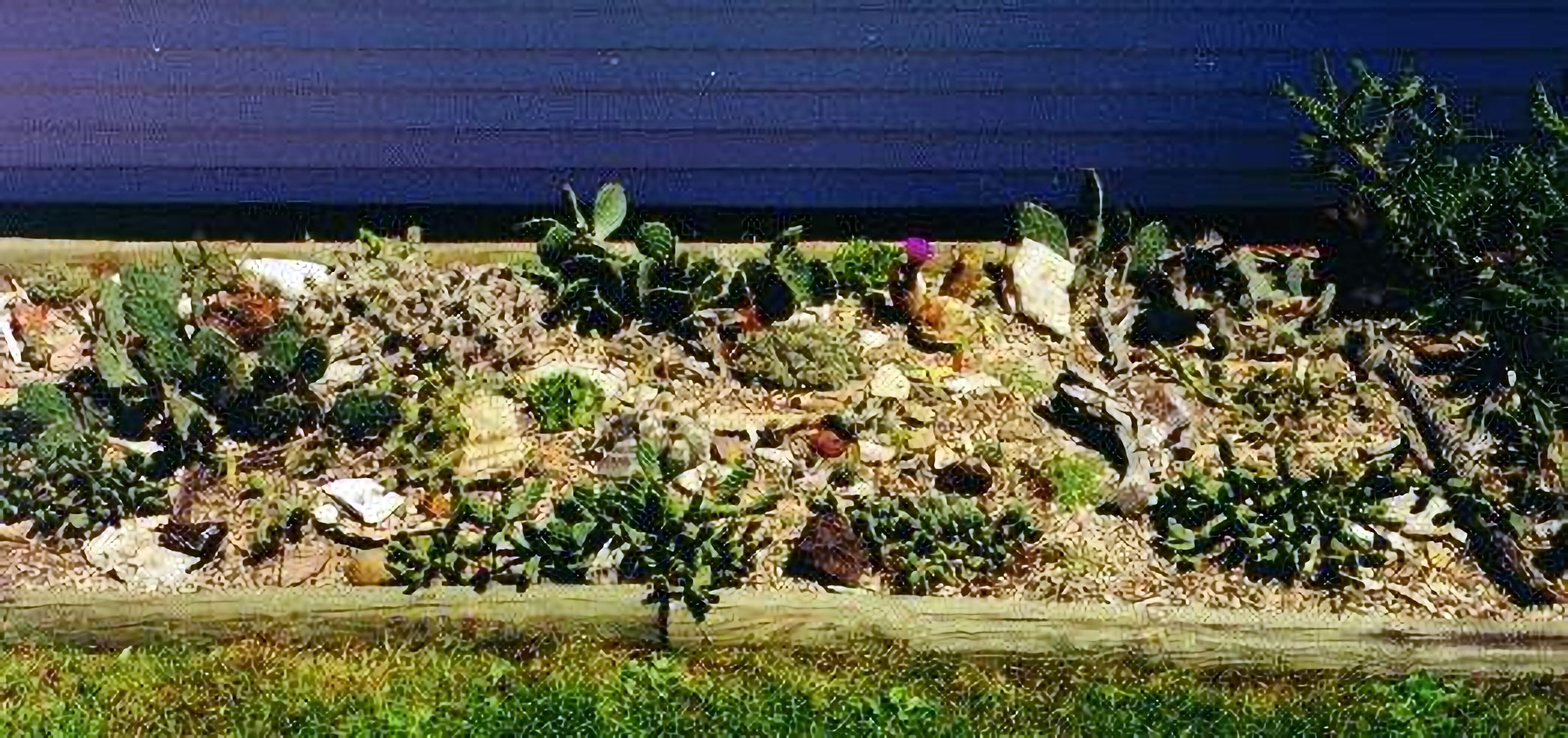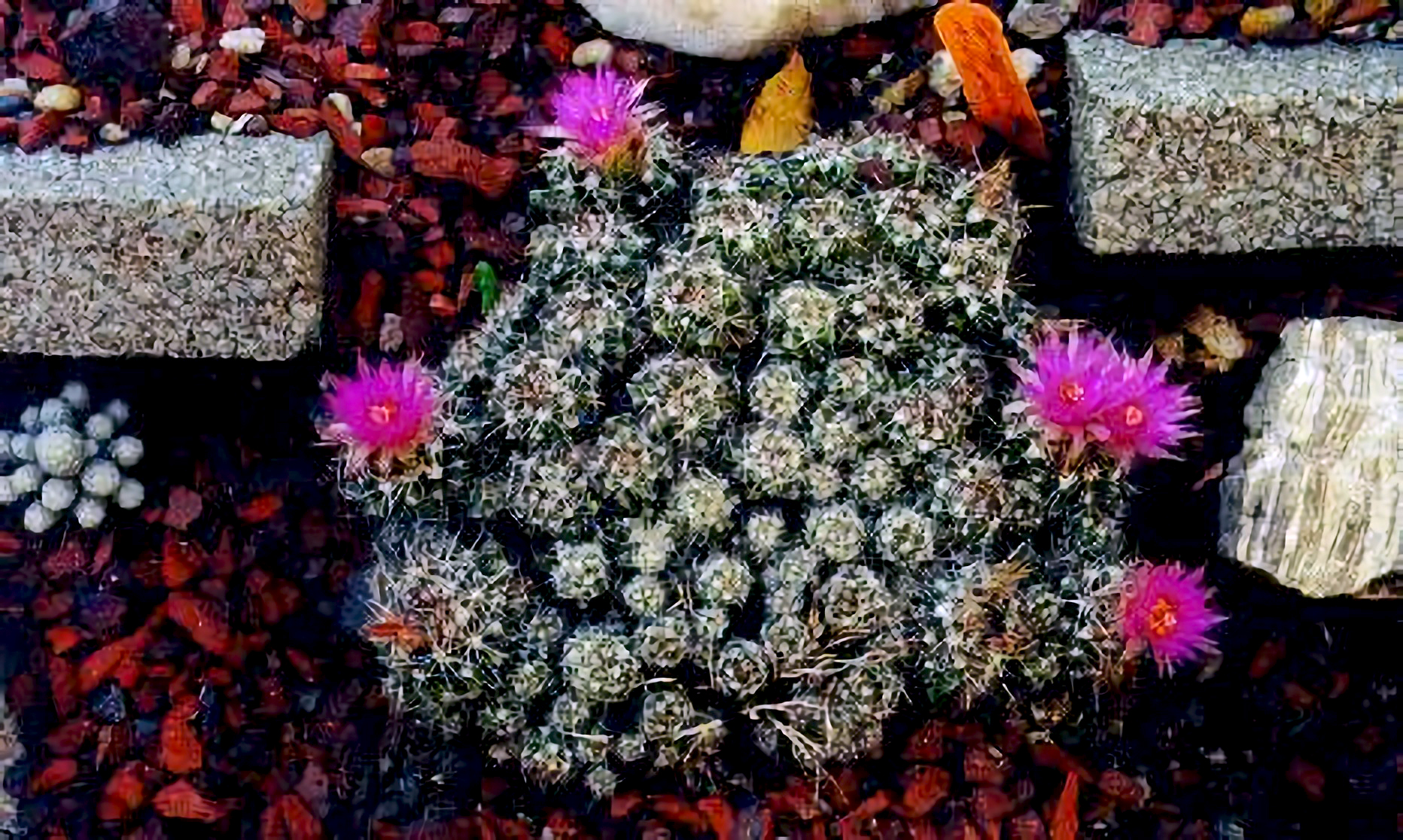By Chuck Staples (April 2001)
Des Moines, Iowa, USA
Member of Mid-Iowa Cactus & Succulent Society
![]()

I have had a winter-hardy bed of mostly cacti for some 15 years on the south side of the front of my white sided house. It is in a protected area from the north-west winter winds due to the living room that juts out on the west side of the bed as far as the front of the bed. There is also a 3½ foot overhang on the house above most of the plant bed which is a help during the cold, wet winters we have here.
A couple of years ago, my son, Andrew, helped me completely rebuild this bed to raise it higher in the back and bring it about a foot away from the house. Otherwise, the size of the bed is about the same as before.
We used 4″ X 5″ X 8′ landscape timbers for the borders so that the whole bed is about 16 feet long and 5 feet wide. (Photo above.) The bed is made up of about ½ sand and ½ soil with pea gravel as top dressing. We used rock shale from 1 to 1½ inches thick and from 1 to 2 feet in rough circumference to bury in appropriate places in the bed with the front part of the shale sticking out an inch or two to pick up the winter sun. This shale is buried slanted downward a little in the raised bed so that the plant roots will reach the rock. Hopefully, the winter sun heats the exposed portion of the rock to warm the roots of the plants during the winter nights and gives the plants a better chance to survive our long, cold, wet winters. And, so far, I have had excellent results with cacti and succulents in the new bed … better than in the old bed without the rock shale.
In this bed are various prickly pear opuntias, Cholla cactus (Opuntia imbricata), a large cluster of Neobesseya missouriensis (plus some smaller ones), Sempervivum ‘oddity’, various Echinocereus species, Coryphantha vivipara, Agave utahensis and a Lewisia species. Included in the bed are various rocks we have collected over the years on our camping trips.
I have also had a cactus and succulent bed in the backyard for a number of years, but it was never an ideal place being shaded by our garage and camper. There was a lot of winter kill in this bed each year, partly, I believe, from the cold northwest wind and partly from lack of warmth from the winter sun. Last summer I decided to rebuild it nearer the northeast corner of our street corner lot away from the garage and camper. The basic design was completed before winter and I planted cactus and succulent plants in the bed this spring. This bed might be called our Rock Garden, made up of rocks my wife, Connie and I collected over the years in the western mountains of the United States, with cactus and succulent plants next to them.
The bed is triangular shaped next to our cement driveway facing south, Southeast; the back of the bed three feet above the driveway. I had a lot of cement blocks left over from an old greenhouse I tore down a few years ago. These I used as raised borders next to and above railroad ties around the back of the bed and in front of Connie’s flower garden. To raise the bed even higher, I placed a number of these cement blocks about a foot in from the back of the bed higher than the blocks around the border. Instead of rock shale to bury in the bed I used cement stepping stones (4″ X 8″ X 1″). With these buried in the bed and many collected rocks at soil level, some warmth from the winter sun will hopefully help this bed survive our cold, wet winters. To the left behind the bed is a lilac hedge and to the right is a neighbour’s hedge. However, with the leaves off during the winter, the hedges give little protection from the winter weather. This back yard cactus and succulent bed gets sun from about 9am to 5pm.
Planted in the cement blocks are mostly sedums and sempervivums. Otherwise, cacti planted here are about the same as in the front yard. I took the loose cactus and succulent soil from the other bed in the backyard and added more sand and pea gravel to give a nice, loose mix. The top dressing is crushed red brick.

This photo shows a Coryphantha vivipara cluster in bloom (in Bed #2), cement stepping stones, collected rocks and an Escobaria leeii (one of three) that I hope to winter over for the first time. I also hope to winter over Agave utahensis for the first time (from club member, Thomas Schwink).
This Coryphantha vivipara has a story to tell. It grew in grass for the last few years in my aunt’s yard (Meade County, Kansas). As the plant got too big (tall), the mower cut off the top of the plant and after a few years it clustered into many pups growing out of the damaged parts. In adapting to this environment (the mowing and the hot sun), the plant had pulled itself down into the ground. When my aunt allowed me to dig it up this past April, most of the body of the plant was underground, enough so that when the mower went over it that morning, very little damage was done to the plant. It is amazing what these plants will do to survive.
As much as possible, I have planted the same species in both cactus and succulent beds. That will give me a comparison as to which bed gives me the best results after next winter. Both beds give us flowers of yellow to pink to red.
Rescued from The Wayback Machine.
© Copyright THE AMATEURS’ DIGEST
![]()
